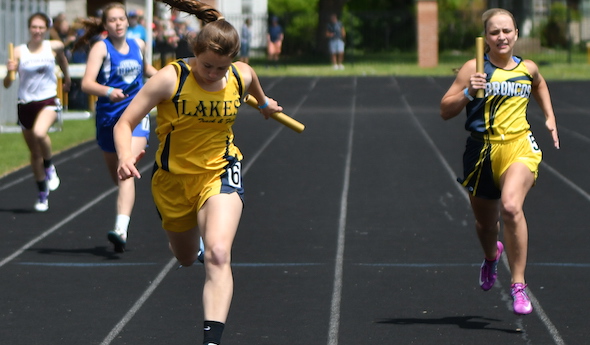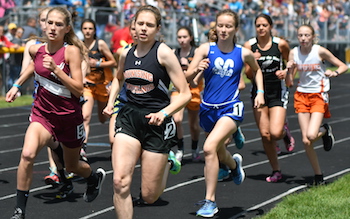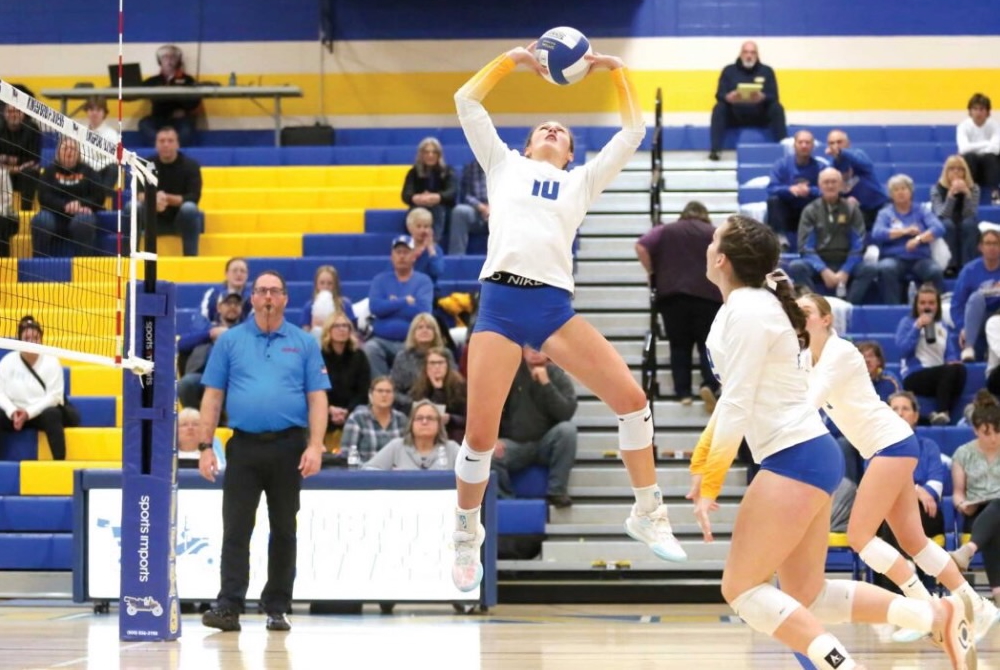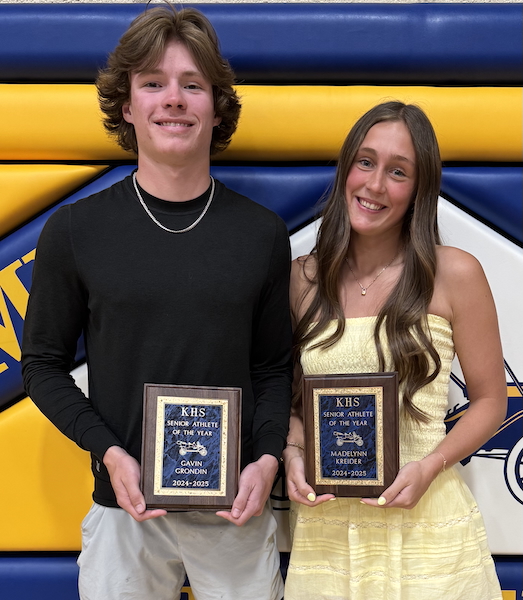
Lakes' Superior Spring Closes with Repeat
By
John Vrancic
Special for MHSAA.com
June 3, 2018
KINGSFORD — The Lake Linden-Hubbell girls enjoyed a banner day at Saturday’s Upper Peninsula Division 3 Track & Field Finals, retaining their title with 96 points.
LL-H senior Laura Lyons won long jump at 16 feet, 1/2 inch, placed second in the 200 in 27.34 seconds and third in the 100 (13.4).
“I got that (distance) on my first jump,” said Lyons, bound for Michigan Tech this fall. “It was really nice to have that cushion. I felt I could afford to gamble with my steps a little.
“It’s amazing to do this two years in a row. Coach Gus (Gary Guisfredi) did a great job with us. It was a lot of fun being with the same group of girls. We had a lot of returners and a lot of younger girls. It’s really like a family on this team. We spend a lot of time together. Many of the girls who didn’t qualify for the Finals came down here to cheer us on.”
They were followed by Felch North Dickinson with 63 points and Stephenson 49.
Jamie Hendrickson added a first in high jump (4-10) and helped the Lakes take the 800 (1:53.22) and 1,600 relays (4:28.95), and MacKenzie LePage took pole vault (9-0).
North Dickinson’s Masyn Alexa won the 100 (13.19) and 200 (27.18) and took second in the 400 (1:01.64), and helped the Nordics place second in the 1,600 relay (4:31.67).
“Lake Linden is solid,” said Nordics’ coach Mike Roell. “We really performed well today. We had some girls really come through.
 “Our team has really improved. Masyn had a big day, and Briana Smith got us the points we needed.”
“Our team has really improved. Masyn had a big day, and Briana Smith got us the points we needed.”
Bark River-Harris won the 400 relay in a school-record 53.63 and added another school record with a third-place finish in the 800 relay (1:53.77). Rock Mid Peninsula was runner-up in the 800 relay in a school-record 1:53.35.
“It’s pretty awesome to set school records in two relays,” said BR-H senior Jaelin Lockwood, who was runner-up in long jump (15-4¾) and fourth in the 100 (13.41). “The 100 wasn’t my best, but Masyn came out of nowhere. Everybody seemed to have little bit of an off day in long jump.
“I’ll remember this season. We had good competition and a good year. I’ll probably be back next year to help with the team.”
Munising junior Madeleine Peramaki was a triple winner, taking the 800 (2:23.05), 1,600 (5:27.66) and 3,200 (12:26,31). She also qualified in the 400, but elected to scratch.
“I qualified in four events, which I didn’t think worked too well,” she said. “I have big goals but just try to do what I can with what I have. I didn’t quite reach the goals I had, but I’m happy with my times.”
PHOTOS: (Top) Lake Linden-Hubbell’s 800 relay anchor extends past the finish line during Saturday’s Finals. (Middle) Munising’s Madeleine Peramaki, second from left, leads the pack around a bend during the 1,600. (Photos by Cara Kamps. Click for more at RunMichigan.com.)

Kingsford's Kreider Prepared for Next Level After Finishing Stellar Flivvers Career
By
John Vrancic
Special for MHSAA.com
June 19, 2025
KINGSFORD — After completing a successful high school volleyball career, Maddy Kreider is ready to take the next step.
 The Kingsford senior is taking her talents to Michigan Tech, where she’s expected to continue primarily as a setter.
The Kingsford senior is taking her talents to Michigan Tech, where she’s expected to continue primarily as a setter.
“That will be a big step for sure, but it’ll be exciting being with the girls,” she said. “The girls are taller in college. It will definitely be an adjustment, physically and mentally. We’ll be traveling longer distances, and it’ll be a matter of improving the mental part of my game.”
Kreider was selected the Upper Peninsula’s Defensive Player of the Year her final two seasons after the U.P. Sportswriters and Sportscasters Association began voting for all-U.P. volleyball.
“That’s quite an accomplishment,” she said. “It’s a real honor playing with girls I grew up with. We had a great season.”
The 5-foot-8 setter was a four-year starter and two-year team captain at Kingsford, leading the Flivvers to three Division 2 District titles and back-to-back undefeated Great Northern Conference championships. She twice was named GNC Player of the Year.
She was also selected all-state first team in the fall and all-state second team in 2023, and all-region throughout her prep career. Her serving percentage also topped .900 throughout her four seasons on varsity.
 Last fall, the Flivvers reached the Regional Semifinal at Manistique where they dropped a 3-2 decision to Kingsley.
Last fall, the Flivvers reached the Regional Semifinal at Manistique where they dropped a 3-2 decision to Kingsley.
“I thought we’d get through,” Kreider said. “We came out lights out in the first two sets, then it was close in the last three.”
Also among the team’s highlights this past fall was a victory at Calumet, approximately 2½ weeks after dropping a 3-1 decision to the Copper Kings on Kingsford’s home floor.
“We wanted to play them,” Kreider said. “They’re a great bunch of girls to play against. They’ve been the measuring stick up here for many years. Winning on their floor was super exciting. We knew we had to play well just to be competitive. That was a great confidence builder for our group. We were definitely on a high going into the District.”
The Flivvers opened their postseason with a 3-1 triumph over Houghton, then defeated Escanaba in straight sets in the District Final.
Kreider will join Calumet senior Maddie Torola at MTU this fall. Torola, who recorded a season-high 19 kills in the four-set victory at Kingsford, helped the Copper Kings finish 29-5 and reach the Division 3 Regional Final at Sault Ste. Marie where they dropped a 3-2 decision to Traverse City St. Francis.
“It was fun playing against her in high school,” Kreider said. “It will be even more fun playing as teammates. It’ll be exciting to be playing on the same team.”
Both will be playing under new head coach Cindy Pindral at Tech. Both of Kreider’s parents played for the Huskies, her mother (and Kingsford varsity coach) Jaclynn volleyball from 1998-2002 and her father Jason basketball from 1997-2000.
Maddy Kreider recently earned an additional honor when she was selected Female Athlete of the Year for Kingsford’s Class of 2025. She recently completed a solid track & field season for the Flivvers.
At the U.P. Division 1 Finals, Kreider placed fourth in the 100-meter dash (13.2) and anchored the Flivvers to a third-place finish in the 800 relay (1:51.57) and fourth in the 400 (53.03) on their home track.
Kreider was named one of 32 MHSAA/Farm Bureau Insurance Scholar-Athlete Award winners this winter and plans to study exercise science and kinesiology at MTU.
 John Vrancic has covered high school sports in the Upper Peninsula since joining the Escanaba Daily Press staff in 1985. He is known most prominently across the peninsula for his extensive coverage of cross country and track & field that frequently appears in newspapers from the Wisconsin border to Lake Huron. He received the James Trethewey Award for Distinguished Service in 2015 from the Upper Peninsula Sportswriters and Sportscasters Association.
John Vrancic has covered high school sports in the Upper Peninsula since joining the Escanaba Daily Press staff in 1985. He is known most prominently across the peninsula for his extensive coverage of cross country and track & field that frequently appears in newspapers from the Wisconsin border to Lake Huron. He received the James Trethewey Award for Distinguished Service in 2015 from the Upper Peninsula Sportswriters and Sportscasters Association.
PHOTOS (Top) Kingsford’s Maddy Kreider sets for her teammates during a match last season. (Middle) Kreider, right, takes a photo with Kingsford’s Male Athlete of the Year Gavin Grondin. (Photos provided by the Kingsford athletic department.)

